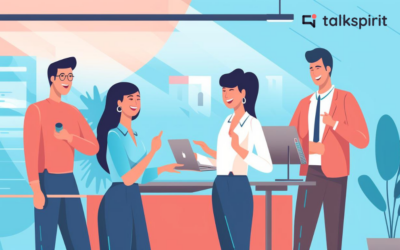57% of employees are considering quitting their job to work for a company that better supports their well-being at work¹. Faced with this growing challenge, more and more companies are now investing in initiatives to improve their team’s well-being and restore meaning to their work.
These initiatives can have many benefits for companies and their employees, including: increased productivity, greater psychological safety, better work-life balance, improved recognition, and ultimately, a better quality of work life (QWL).
To succeed in this approach, however, you need to be well equipped! Here are six types of software to help you improve employees’ well-being at work.
1. Internal communication tools
A recent study conducted by Grammarly showed that companies with 15%+ employee turnover were 34% more likely to report communication issues in the past year. This proves that internal communication plays a key role in retaining talent.
But that’s not all. Sharing information better internally can also make employees’ work easier. Good internal communication also means less time spent searching and asking around for information.
To facilitate this flow of information, you can use an internal communication tool such as Talkspirit that enables you to:
- assemble all your employees on the same platform, whether they work in the office, at home, or in different locations
- share events via a welcome portal
- develop mutual support and idea sharing by creating dedicated dedicated communities
- highlight individual and collective successes on a news feed
- facilitate synchronous and asynchronous exchanges via chat and videoconferencing
More than just an intranet, Talkspirit offers you a complete suite for better team communication and external collaboration, no matter where you’re working.
2. Employee engagement software
Employee engagement is one of the key drivers of well-being at work, yet today, only 23% of employees report they’re truly engaged in their work, according to this Gallup study.
A number of software programs can help you rekindle employee engagement and promote a psychologically safe working environment where everyone feels free to express themselves. Software such as Bleexo, Zest, Supermood, Culture Amp, or Limeade Listening, for example, enables you to:
- gauge social climate, employee satisfaction, and well-being
- assess individual commitment and performance
- identify employees’ strengths and areas for improvement
- facilitate feedback through 360° feedback (an evaluation process that gathers the opinions of everyone who interacts with the employee)
3. Recognition software
Another way of developing commitment is to recognize employees’ work—both verbally and through rewards (like a gift or bonus).
According to a Moodwork study for My Happy Job, only one in four employees claim to receive recognition from their company! From colleagues and direct managers, yes. But from the company itself, they come few and far between.
Meeting this need for recognition is essential to developing well-being at work. A report by Gallup and Workhuman shows that employees who feel recognized for their work are 10 times more likely to have a strong sense of belonging to their company. What’s more, those who have received strong recognition the previous day are up to four times more likely to say that their company cares about their well-being.
A number of software programs can help you to improve recognition and thus develop your employees’ well-being at work. These include:
- Nectar: a platform that encourages recognition and enables you to offer gifts to your employees
- Bonusly: a software program that lets you create a culture of recognition through a system of points and rewards
- Guusto: a platform for creating recognition programs, managing budgets, and tracking engagement objectives
- Kudoboard: a tool for collecting messages, photos, and videos on an online board (to thank an employee for his or her involvement in a project, or to celebrate a professional anniversary).
4. Workplace wellness tools
In addition to engagement and recognition platforms, there are also workplace wellness tools specializing in physical and mental well-being issues. Here are just a few examples:
- Moodwork: a platform for improving the mental health of your employees, thereby reducing psychosocial risks.
- Wellness 360: comprehensive software offering QVT programs and challenges as well as support services to boost well-being at work.
- Headspace: an application to introduce your employees to meditation and thus reduce their stress at work.
- Yumuuv: an application that lets you create challenges to improve your teams’ physical and mental well-being.

5. Gamification tools
Gamification—incorporating elements of games, fun, and competition into the work environment—is a major asset in developing well-being at work. Often used in the context of training courses or workshops, this method encourages employee participation through playful initiatives such as a points system, leaderboard, quizzes, competitions, and rewards.
Several gamification software packages offer these features:
- Upshot.ai: the gamification solution to improve employee engagement, replete with mini-games, quizzes, and a badge system.
- Gametize: the tool to gamify your internal communication with challenges, instant feedback, and rewards.
- Kahoot: the platform to energize your internal meetings and events with interactive timed quizzes and neat graphics.
- Drimify: the tool for creating games and interactive experiences in just a few clicks.
6. Self-management software
Other software programs can also enhance well-being at work. We’re of course talking here about self-management tools! If you’re not familiar with the concept, here’s a definition to make things more clear:
Self-management is the ability to control our emotions and behavior in different situations. It’s a soft skill that’s indispensable today for gaining autonomy, adapting to change, staying motivated, managing stress and even making decisions.
By developing self-management, organizations can move away from the classic pyramidal hierarchy towards a liberated company philosophy where everyone can take the initiative. Each employee can thus become a full-fledged player in the organization and freely decide what he or she needs to do to achieve the objectives specific to his or her role.
Even less known, self-management software is a lever for developing information transparency, agility, and well-being at work. Holaspirit software makes this possible with features like:
- The organization chart, which visualizes everyone’s roles in circles (not the traditional pyramid), and identifies who is responsible for what.
- OKRs (Objective Key Results), a method for aligning teams with the objectives and results to be achieved.
- Governance proposals, which enable everyone to propose the creation (or modification) of a role or policy and make decisions asynchronously.
- The meetings module, which allows you to structure meeting time into different stages (inclusion round, action checklist, KPIs, projects, agenda items, closing round, etc.).
In conclusion
By now, you’re familiar with the main software solutions for enhancing your employees’ well-being at work. Of course, there’s no point in deploying 1,000 copies of software all at once: the important thing is to choose the one or ones that best suit your needs. To accomplish this, ask yourself what your company’s priority is. Is it to improve internal communication? Develop recognition? Empower employees? Improve individual commitment and involvement? The answer will tell you which software you need to invest in. 😉
Want still more advice on choosing your software for improving well-being at work? Contact our team today to find out more.



